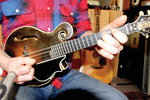When a record is captured live at a recording studio, not dubbed track by track, the musical relationship between players is front and center.
That is the abstract essence, the “magic,” that Matt Sircely decided he wanted to capture when he entered Rainshadow Recording in Fort Worden to work on his newest album.
This item is available in full to subscribers.
We have recently launched a new and improved website. To continue reading, you will need to either log into your subscriber account, or purchase a new subscription.
If you had an active account on our previous website, then you have an account here. Simply reset your password to regain access to your account.
If you did not have an account on our previous website, but are a current print subscriber, click here to set up your website account.
Otherwise, click here to view your options for subscribing.
* Having trouble? Call our circulation department at 360-385-2900, or email our support.
Please log in to continue |
|



When a record is captured live at a recording studio, not dubbed track by track, the musical relationship between players is front and center.
That is the abstract essence, the “magic,” that Matt Sircely decided he wanted to capture when he entered Rainshadow Recording in Fort Worden to work on his newest album.
“When I bring the songs in, everybody can do it differently,” Sircely said. “You can make something from the ground up, or you can record it all live. I decided to record everything live, and I just wanted to sit down and have fun. I wanted to capture me with two of the best musicians I know, having fun and feeling comfortable. I think that is one of the hardest things to have come through on a record.”
That essence will be on display during a a free show at 2 p.m. Feb. 12 at Avamere at Port Townsend, 1201 Hancock St. The show is the latest in the Northwind Arts Center’s Arts to Elders series.
“Matt Sircely is the first call, go-to mandolin player in a town full of them, and he’s a heck of a nice guy, which shows every time he takes the stage,” said Matt Miner, who manages the Arts to Elders series.
For more information, call 360-379-1086 or visit the Northwind Arts Center website.
New album
The album, not yet titled, will include 14 original songs on which Sircely played mandolin and sang. Guitarist Chris Luquette and electric bass player Danny Barnes joined Sircely.
“When we came into the studio, I had everything charted, and I had made sure everybody knew what to do, and then I really let it roll,” Sircely said. “The songs are a template and can be played differently every time. I really like to have that improvisational basis in the songs. There are all these other pieces that come in, the fills, the solos, the harmonies. It is a very fun process, and to think of all those at the same time, to capture real, live improvisation in recording is really special.”
Sircely said he chose Luquette to join him as an “interpreter” of his songs.
“He is a spectacular guitar player,” Sircely said. “He won the International Bluegrass Music Association guitar player of the year award.”
Barnes, who often plays banjo, added another dimension of sound.
“It was just incredible to hear Barnes play on the bass because he is such an experienced musical architect, and he knows songs so well,” Sircely said. “Really, it means a lot to have his support on the project.”
Lifelong pursuit of excellence
This latest album is Sircely’s most recent attempt to scale the heights of the mandolin world, something he said can never truly be achieved.
“As part of learning mandolin, I have been humbled for 20 years over and over again,” he said. “I just keep trying to do better, learn more and play great. It is an endless struggle. Everybody goes through it. I am not sure if anybody ever feels they have arrived, and that is a good feeling to keep that humility, and to keep chasing a sense of what you perceive to be great.”
As a young boy, Sircely started on a guitar.
“I was self-taught, and I played the guitar in a pretty strange way,” he said. “I played a lot of slide guitar and open tunings. I was pretty isolated. I had some friends in high school who taught me some chords. I figured out a lot of stuff about myself off of the radio and from recordings. And yet, it was really limiting to play guitar in such an odd way musically because it made it more difficult to study guitar in standard tuning. I wanted to branch out.”
During his college years, Sircely found himself in Boise, Idaho, with a decision to make.
“I asked a friend who was visiting, ‘Should I get a dobro or mandolin?’ And he said, ‘Get a mandolin,’” Sircely said. “I went down to the music store, and I grabbed a mandolin, and I felt its vibrations against my diaphragm as I am holding it in my lap. It brought me to tears. I bought it, and I walked around in the streets of Boise for days, playing the simplest chords. I was so happy.”
Sircely started playing gigs with the mandolin immediately, even though he had not yet become proficient.
“When I went back to college in New York state, we were fortunate to be the only college outside of the city that had an actual jazz professor,” Sircely said. “A real great jazz professor that everybody loved, Dr. Mike Woods. I asked him if I could bring a mandolin into the jazz improvisation class. He really couldn’t see why anyone would want to do that.”
Reservations aside, Woods agreed to let Sircely sit in with the jazz band.
“He taught me to improvise,” Sircely said. “He taught me to play. The first things I learned on mandolin were the geometric shapes that make up the arpeggios and just the overall geometry of the mandolin. The tuning in fifths is incredibly logical, and to have an introduction from a professor where I am walking through the things more advanced students are doing, and kind of faking it, it opened up the entire mandolin to me and taught me music theory in a deeper way than I had perceived it before. I didn’t notice when I crossed that threshold, but he yelled at me one time, ‘See! You couldn’t do that before.’”
A zillion ways to play
With the improvisational skills he learned through jazz, Sircely set out to further expand his musical reach.
“I picked up the mandolin to broaden my horizons, to achieve more of a direct access to the musical muse in terms of playing an instrument that really works for me in a pre-verbal way,” he said. “There is a zillion ways to play the mandolin. There is a mandolin equivalent in tons of different cultures around the world. The mandolin is huge is Italy, Mexico, Brazil, Russia, Ireland. It goes on and on. And so, in my studies … I have played with many different groups and learned how to communicate in many different styles. Often it is a cultural thing. Each style is like its own language with its own set of table manners and its own sense of decorum or hierarchy in the ensemble.”
In the process, Sircely said he learned to become reasonably proficient in many different styles and many different sounds.
“That is something that has greatly impacted my approach to the mandolin,” he said.
Another unique factor is with the hardware he uses.
“The other thing that really drives my approach to the mandolin are the choices that you make when you set up your instrument, choose a pick, choose your strings,” he said. “You can go for light and fast and fancy, or you can go for deeper, slower, more simple and clearer. And, there is a full spectrum in between that, where some mandolins have a gentle or fast or nimble approach, and some mandolin players will go for something deep and throaty and guttural, which is what I perceived as more of an old-school thing. I like the old sound of the wood. I like all the modern music, too.”
Sircely prefers to use heavy round picks.
“They are not as nimble and fast, but they make the wood sing in a deeper way,” he said. “It is a little more difficult than having a lightning-fast setup. But I really love that side of the mandolin, and you can always play light. I really like to be able to dig in with a big chop or a big chord and have the mandolin respond because it is set up to handle a big attack. My mandolin responds to that.”
Sircely’s mandolin is heavy and robust.
“It doesn’t necessarily play itself like some mandolins do,” he said. “I like that because it makes you play it, and it sounds good to play the mandolin the way I imagine people played the mandolin before microphones or in the early days of microphones. It is fun ... having a setup where you can really play it in a way that is going to make the wood resonate fully.”
Finding healing
Since Sircely began writing songs as a kid, he has found the process to have a healing quality.
“When you are really bummed out in high school, and you write a song and it makes you feel better, a lot of people have had that experience, and that is a big reason why I got started, and now I realize that I can use music to try and help other people feel better,” he said. “There are times when I felt my goal in music was to wake up society or something. I feel like society is waking up. That means that my songs make more sense than they did to the general population 15 years ago. People get them now, and that is cool because they still hold water.”
During the contentious 2018 Senate hearings to confirm Brett Kavanaugh as a Supreme Court Justice, Sircely said he became aware of an invisible tension that settled upon his audience.
“They were traumatized emotionally, and so I designed my entire set to be about things that were uplifting, upstanding, morally responsible, honest love, good-felt, cultural elements. And people realized what I was doing, and they started to smile, and it helped them, and it helped me. And it showed me that songs really are as important as I always thought they were. Sometimes it takes a dark time to remind us of that, and we are sure grateful we have those songs when we are in that dark time.”